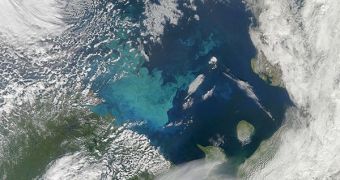In an interesting twist, some of the world's smallest microscopic organisms, collectively called phytoplankton, can come together in structures known as blooms, which can be seen from orbit. Now experts try to understand why phytoplankton blooms develop.
According to investigations, it would appear that the blooms only occur when a certain mix of conditions is met. The gigantic events that can be seen from space cannot take place anytime, anywhere, researchers say.
Satellites have become adapt at finding the brilliant aquamarine patches of ocean that are indicative of phytoplankton blooms. The instruments have captured a wide photo collection showing this type of events.
The most interesting thing about them is that they are of biological origin, which is very peculiar considering the sizes they grow to reach eventually.
Coccolithophores are poorly-understood types of phytoplankton that permeate the upper layers of any bloom, but their exact function, and the mechanisms through which it arrives at its domination have thus far remained uncertain.
“Coccolithophores are a complex group of plankton, and in many areas of the world ocean satellite-based observations provide the only information we have,” explains marine scientist Stuart Painter.
“We often have little direct knowledge of the environmental factors coincident with these blooms,” adds the expert, who is based at the National Oceanography Center (NOC), in Southampton, England.
In a recent series of scientific observations, experts using satellites discovered that a certain mix of conditions needed to take place in order for the blooms to happen.
These conditions included certain mixtures of nutrients being present in the water, as well as a very specific temperature. If any of these “demands” were not met, then no bloom occurred.
“The marine environment of the Patagonian Shelf region is well known for its complexity, but what has been less clear until now is how this relates to the large blooms of coccolithophores in this region,” Painter explains of the region where the studies were conducted.
According to a paper the researchers published in the October 31 online issue of the scientific journal Continental Shelf Research, it would appear that blooms occur at the confluence of different water masses, which can be discerned by the color of the chlorophyll the small organisms contain.
“The complex interaction of large currents and different water masses clearly exerts strong controls over the position of coccolithophore blooms in this region,” Painter concludes, quoted by Wired.

 14 DAY TRIAL //
14 DAY TRIAL //